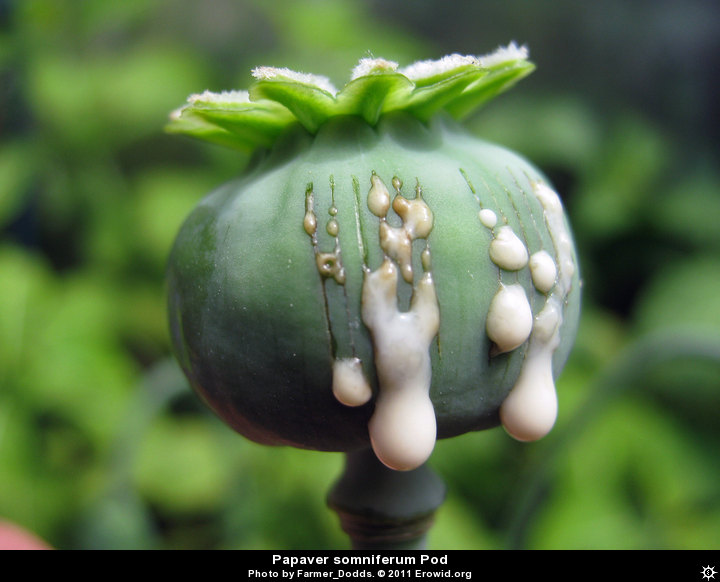Opioids
General information
Opiates and opioids are classes of depressant analgesics derived from or chemically similar to substances found in Papaver somniferum, the opium poppy. They include both naturally occurring and synthetic substances. The term opiate is often used interchangeably for opioid. Opiate is limited to the natural alkaloids found in the resin of the poppy. Opioid refers to both opiates and synthetic substances as well as opioid peptides. The analgesic effect of opioids are due to decreased perception of pain, decreased reaction to pain as well as increased pain tolerance. They can also be used as for their antitussive properties.
Common opioids:
History

Opioids are among the world's oldest known drugs; the therapeutic use of the opium poppy predates recorded history. Excavations of the remains of neolithic settlements in Switzerland (the Cortaillod culture, 32002600 B.C.), have shown that Papaver was already being cultivated then; perhaps for the food value in the seeds (45% oil), which we know as poppy seeds. The slightly narcotic property of this plant was undoubtedly already known then.
Opium contains a considerable number of different substances, and in the nineteenth century these were isolated. In 1806 Friedrich Serturner was the first to extract one of these substances in its pure form. He called morphine after Morpheus, the Greek god of sleep. Codeine (Robiquet, 1832) and papaverine (Merck, 1848) followed. These pure substances supplanted the use of raw opium for medical purposes. Like opium they were frequently used as painkillers and as anti-diarrheal. The invention of the hypodermic needle in the mid-nineteenth century lead to widespread use of morphine intravenously as a painkiller and recreational drug.
Effects
All opiate drugs have similar effects. At low doses they relieve pain and anxiety, and if the dose is increased, they produce a sedative effect.The analgesic (painkiller) effects of opioids are due to decreased perception of pain, decreased reaction to pain as well as increased pain tolerance. Opioids can cause cough suppression, which can be both an indication for opioid administration or an unintended side effect.
Opiates influence the pupils: they contract (miosis). This is an extremely reliable signal of opiate use. Besides this, when suffocation occurs (as a result of respiratory inhibition) in the case of an overdose, the pupils dilate (mydriasis).
The most striking quality of painkilling effect of opiates is that it has virtually no effect whatever on the other sensory perceptions, consciousness or the motor functions. All other substances with a painkilling effect, such as laughing gas, alcohol, ether and barbiturates also have, in an effective dose, a definate effect on consciousness, motor coordination, the intellect and emotional control. The drowsiness which can be caused by opiates is experienced only at high dosage.
Opiates are affecting respiratory center. Both frequency and the depth of breathing is reduced. In the case of overdose, respiration can come to a complete halt resulting in death.
Dependence is characterised by unpleasant withdrawal symptoms that occur if opioid use is abruptly discontinued. The withdrawal symptoms for opiates include severe dysphoria, craving for another opiate dose, irritability, sweating, nausea, rhinorrea, tremor, vomiting and myalgia.
Positive
- Euphoria
- Analgesic effect
- Pain relief
Neutral
- Itching
Negative
- Opioid-induced hyperalgesia (More sensitive to pain after stopping the use)
- Nausea
- Vomiting
- Constipation
- Respiratory depression
Addiction
Opiates also give us the classical model of addiction. Used regularly, they produce tolerance - a need to continue increasing the dose in order to get the same effect, and stopping after repeated use produces withdrawal symptoms that can reinforce the addiction - physical discomfort and a mental craving for the drug, driving the user to continue taking the drug despite negative consequences of behavior.
Chemistry and Pharmacology
An opioid is any psychoactive chemical that resembles an opiate in its pharmacological effects. They work by binding to the opioid receptors (Delta, Kappa, Mu) Which are found in the Central/Peripheral nervous system and in the GI tract.
Harm Reduction
Avoid driving on higher doses.
Opioid analgesics do not cause any specific organ toxicity, unlike many other drugs, such as aspirin and acetaminophen. They are not associated with upper gastrointestinal bleeding and renal toxicity, however people seeking codeine experiences from medications that contain acetaminophen (paracetamol) may be putting themselves at risk for acetaminophen-related complications such as liver damage.
Interactions
Don't mix any of the class with any other CNS depressants as it increases the risk of an overdose, and respiratory depression.
Tramadol and Meperidine are affecting serotonin levels in the brain, and might cause Serotonin Syndrome with some combinations. Check Drug Combinations for more information.
Links
https://en.wikipedia.org/wiki/Opiod
http://www.drugtext.org/sub/opiat1.html
http://www.erowid.org/chemicals/opiates/opiates_mcdermotts_guide.shtml